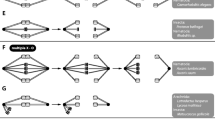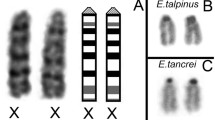Abstract
During meiosis I, homologous chromosomes join together to form bivalents. Through trial and error, bivalents achieve stable bipolar orientations (attachments) on the spindle that eventually allow the segregation of homologous chromosomes to opposite poles. Bipolar orientations are stable through tension generated by poleward forces to opposite poles. Unipolar orientations lack tension and are stereotypically not stable. The behavior of sex chromosomes during meiosis I in the male black widow spider Latrodectus mactans (Araneae, Theridiidae) challenges the principles governing such a scenario. We found that male L. mactans has two distinct X chromosomes, X1 and X2. The X chromosomes join together to form a connection that is present in prometaphase I but is lost during metaphase I, before the autosomes disjoin at anaphase I. We found that both X chromosomes form stable unipolar orientations to the same pole that assure their co-segregation at anaphase I. Using micromanipulation, immunofluorescence microscopy, and electron microscopy, we studied this unusual chromosome behavior to explain how it may fit the current dogma of chromosome distribution during cell division.







Similar content being viewed by others
References
Araujo D, Maia UM, Brescovit AD (2010) The first cytogenetic characterization of the poisonous black widow spider Latrodectus gr. curacaviensis from Brazil, with chromosomal review of the family Theridiidae (Arachnida, Araneae). Micron 41:165–168
Araujo D, Schneider MC, Paula-Neto E, Cella DM (2016) The spider cytogenetic database. Available: www.arthropodacytogenetics.bio.br/spiderdatabase
Ault JG (1984) Unipolar orientation stability of the sex univalent in the grasshopper (Melanoplus sanguinipes). Chromosoma 89:201–205
Ault JG (1986) Stable versus unstable orientations of sex chromosomes in two grasshopper species. Chromosoma 93:298–304
Ault JG, Nicklas RB (1989) Tension, microtubule rearrangements, and proper distribution of chromosomes in mitosis. Chromosoma 98:33–39
Ault JG, Rieder CL (1994) Meiosis in Drosophila males. I. The question of separate conjunctive mechanisms for the XY and autosomal bivalents. Chromosoma 103:352–356
Benavente R, Wettstein R (1977) An ultrastructural cytogenetic study on the evolution of sex chromosomes during the spermatogenesis of Lycosa malitosa (Arachnida). Chromosoma 64:255–277
Fabig G, Müller-Reichert T, Paliulis LV (2016) Back to the roots: segregation of univalent sex chromosomes in meiosis. Chromosoma 125:277–286
Hackman W (1948) Chromosomenstudien an Araneen mit besonderer Berucksichtigung der Geschlechtschromosomen. Acta Zool Fenn 54:1–101
Hard WL (1939) The spermatogenesis of the lycosid spider Schizocosa crassipes (Walckenaer). J Morph 65:121–150
King JM, Nicklas RB (2000) Tension on chromosomes increases the number of kinetochore microtubules but only within limits. J Cell Sci 113(Pt 21):3815–3823
Král J, Korinkova T, Forman M, Krkavcova L (2011) Insights into the meiotic behavior and evolution of multiple sex chromosome systems in spiders. Cytogen Gen Res 133:43–66
Magidson V, He J, Ault JG, O’Connell CB, Yang N, McEwen BF, Sui H, Khodjakov A (2016) Unattached kinetochores rather than intrakinetochore tension arrest mitosis in taxol-treated cells. J Cell Biol 212:307–319
Martindale C (1980) Studies on Latrodectus. Proceedings of the Entomological Congress of the Entomological Society of Southern Africa 3:45–46
McKee BD, Karpen GH (1990) Drosophila ribosomal RNA genes function as an X-Y meiotic pairing site during male meiosis. Cell 61:61–72
Moens PB (1970) Serial sectioning in electron microscopy. Proc Can Fed Biol Soc 13:160
Moore DP, Orr-Weaver TL (1998) Chromosome segregation during meiosis: building an unambivalent bivalent. Curr Top Dev Biol 37:263–299
Nicklas RB (1961) Recurrent pole-to-pole movements of the sex chromosome during prometaphase I in Melanoplus differentialis spermatocytes. Chromosoma 12:97–115
Nicklas RB (1963) A quantitative study of chromosomal elasticity and its influence on chromosome movement. Chromosoma 14:276–295
Nicklas RB, Koch CA (1969) Chromosome micromanipulation. III. Spindle fiber tension and the reorientation of mal-oriented chromosomes. J Cell Biol 43:40–50
Nicklas RB, Kubai DF (1985) Microtubules, chromosome movement, and reorientation after chromosomes are detached from the spindle by micromanipulation. Chromosoma 92:313–324
Nicklas RB, Staehly CA (1967) Chromosome micromanipulation. I. The mechanics of chromosome attachment to the spindle. Chromosoma 21:1–16
Nicklas RB, Ward SC (1994) Elements of error correction in mitosis: microtubule capture, release, and tension. J Cell Biol 126:1241–1253
Nicklas EB, Brinkley BR, Pepper DA, Kubai DF, Richards GK (1979) Electron microscopy of spermatocytes previously studied in life: methods and some observation on micromanipulated chromosomes. J Cell Sci 35:87–104
Nicklas RB, Waters JC, Salmon ED, Ward SC (2001) Checkpoint signals in grasshopper meiosis are sensitive to microtubule attachment, but tension is still essential. J Cell Sci 114:4173–4183
Painter TS (1914) Spermatogenesis in spiders. Zool Jb 38:509–576
Paliulis LV, Nicklas RB (2004) Micromanipulation of chromosomes reveals that cohesion release during cell division is gradual and does not require tension. Curr Biol 14:2124–2129
Patau K (1948) X-segregation and heterochromasy in the spider Aranea reaumuri. Heredity 2:77–100
Revell SH (1947) Controlled X-segregation at meiosis in Tegenaria. Heredity 1:337–347
Suzuki S (1954) Cytological studies in spiders. III. Studies on the chromosomes of fifty-seven species of spiders belonging to seventeen families with general consideration of chromosomal evolution. J Sci Hiroshima Univ Ser B, Div 15:23–136
White MJD (1973) Animal cytology and evolution, 3rd edn. Cambridge University Press, London, p 960
Wise D (1983) An electron microscope study of the karyotypes of two wolf spiders. Can J Gen Cyt 25:161–168
Zhao Y, Ayoub NA, Hayashi CY (2010) Chromosome mapping of dragline silk genes in the genomes of widow spiders (Araneae, Theridiidae). PLoS One 5:e12804
Acknowledgments
We thank E. Stowe for valuable discussion of the manuscript and three anonymous reviewers for their constructive suggestions. We thank C. Kristensen at Spider Pharm for all of his assistance with spiders. The electron microscopy reported in this paper was performed at the Wadsworth Center’s Electron Microscopy Core Facility.
Author information
Authors and Affiliations
Corresponding author
Ethics declarations
Conflict of interest
The authors declare that they have no conflicts of interest.
Human and animal rights
All applicable international, national, and/or institutional guidelines for the care and use of animals were followed. This article does not contain any studies with human participants performed by any of the authors.
Rights and permissions
About this article
Cite this article
Ault, J.G., Felt, K.D., Doan, R.N. et al. Co-segregation of sex chromosomes in the male black widow spider Latrodectus mactans (Araneae, Theridiidae). Chromosoma 126, 645–654 (2017). https://doi.org/10.1007/s00412-017-0628-7
Received:
Revised:
Accepted:
Published:
Issue Date:
DOI: https://doi.org/10.1007/s00412-017-0628-7




